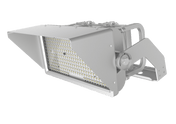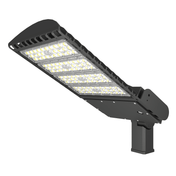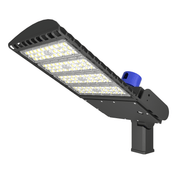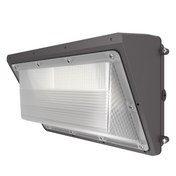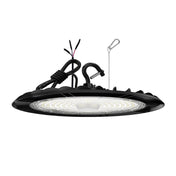What are LED high bay lights?
LED high bay lights, also known as "LED High Bay Lights," are specially designed to provide efficient lighting for tall spaces. They are commonly found in buildings such as industrial plants, warehouses, stadiums, exhibition halls, and large shopping malls. These venues often have high ceilings, ranging from 8 meters to several dozen meters. Conventional lamps struggle to meet these lighting requirements, but LED high bay lights are up to the challenge.
In appearance, LED high bay lights are designed with functionality and durability in mind. Their bodies are typically constructed of high-strength die-cast aluminum, which is not only durable and resistant to shock and vibration but also withstands the rigors of industrial environments. They also offer excellent heat dissipation, quickly dissipating heat generated by the LED chips, ensuring stable operation and extending the lifespan of the lamp. The surface of the lamps is typically treated with an anti-aging electrostatic spray coating, which not only enhances self-cleaning properties, making them less susceptible to dust and stains, but also improves corrosion resistance, ensuring long-term use even in humid, dusty, or chemically aggressive environments.
In terms of optical components, LED high-bay lights are equipped with high-quality LED chips, the core light-generating components. These chips offer advantages such as high luminous efficiency, minimal light decay, and long lifespan. To achieve optimal light distribution, the fixtures also utilize specialized optical lenses or reflectors. These precisely control the direction and distribution of light, ensuring even coverage of the target area, avoiding blind spots and glare, and providing a comfortable, bright visual environment. Furthermore, the shades of LED high-bay lights are often constructed of highly transparent PC or tempered glass, protecting the internal optical and electronic components while ensuring efficient light transmission and minimizing light loss.
Now that you understand the basic definition and appearance of LED high-bay lights, you may be curious about how they work to achieve such efficient lighting. Let's delve deeper into the working principles of LED high-bay lights.
Working Principle of LED High Bay Lights
Power Conversion
The operation of LED high bay lights depends first and foremost on a stable power supply, which involves the power conversion process. While the mains electricity we use in daily life is mostly alternating current (AC), LED chips require direct current (DC) to function properly. Therefore, LED high bay lights are equipped with a dedicated power supply circuit whose core task is to convert the input AC power into DC.
This conversion process is typically accomplished by a rectifier. Common rectification methods include half-wave rectification, full-wave rectification, and bridge rectification. Bridge rectification is widely used in LED high bay lights due to its high efficiency and stability. A bridge rectifier circuit consists of four diodes, cleverly utilizing the unidirectional conductivity of the diodes to utilize both the positive and negative half-cycles of the AC power, thereby outputting a relatively smooth DC power. However, the rectified DC power still exhibits certain fluctuations. To meet the stringent requirements of LED chips for a stable power supply, further filtering circuits, such as capacitors and inductors, are required to smooth out these fluctuations and provide a more stable DC output.
A stable power supply is crucial for the proper operation of LED high-bay lights. If the power supply is unstable, the LED chips will be affected by voltage fluctuations, resulting in unstable brightness, flickering, and even damage. Just like the human heart, if the blood supply is unstable, all body functions will be affected. The same is true for LED high-bay lights. A stable power supply is the fundamental guarantee for their continuous and efficient operation.
LED Chip Lighting
When stable direct current is input into an LED high-bay light, it acts on its core component—the LED chip—causing it to emit light. LED chips are solid-state semiconductor devices whose light-emitting principle is based on the properties of semiconductors.
Inside an LED chip, it is primarily composed of a P-type semiconductor and an N-type semiconductor, which combine to form a P-N junction. In a P-type semiconductor, holes (which can be understood as vacancies lacking electrons) are the majority carriers; in an N-type semiconductor, electrons are the majority carriers. When direct current is applied to this P-N junction through a wire, electrons are pushed from the N-type semiconductor to the P-type semiconductor. In the P-type semiconductor, the electrons and holes meet and recombine. This recombination releases energy, which is emitted as photons (elementary particles of light), thereby converting electrical energy into light energy. This is the fundamental principle of LED chip light emission.
The color of light, or its wavelength, is determined by the semiconductor material that forms the P-N junction. Different materials produce light of different wavelengths. For example, common gallium nitride (GaN)-based LED chips can emit blue light. By coating phosphors on blue LED chips and utilizing the property of phosphors emitting other colors of light after being excited by blue light, white light can be mixed to meet our daily lighting needs for white light.
Cooling System
While most of the electrical energy in LED high-bay lights is converted into light during operation, some energy is converted into heat, causing the LED chips to heat up. If this heat cannot be dissipated promptly, it will severely impact the performance and lifespan of the luminaire. Therefore, an efficient cooling system is an essential component of LED high-bay lights.
The cooling system of an LED high-bay light typically includes a heat sink, vents, and thermally conductive materials. The heat sink is a key component of the cooling system. Aluminum alloy is commonly used because of its excellent thermal conductivity, enabling it to quickly dissipate heat generated by the LED chips. Its relatively low density and light weight make it easy to install and operate. The shape and structure of the heat sink are also carefully designed, typically using a fin-type structure to increase heat dissipation area and improve heat dissipation efficiency. The spacing and height between the fins are carefully calculated to ensure smooth air flow between the fins, dissipating heat.
The vents are also a crucial component of the cooling system. They are strategically located within the luminaire body to facilitate natural convection within the luminaire, accelerating heat dissipation. Some high-end LED high-bay lights are equipped with dedicated cooling fans, which use forced air cooling to further enhance heat dissipation and ensure the LED chips always operate within a suitable temperature range.
Heat dissipation plays a key role in extending lamp life and maintaining stable performance. Excessive temperatures can cause the LED chip's luminous efficacy to decrease, leading to a gradual decrease in brightness. They can also accelerate the aging of the chip's internal materials, shortening the lamp's lifespan. Studies have shown that for every 10°C increase in LED chip temperature, its lifespan can be reduced by approximately half. Therefore, a good heat dissipation system provides a comfortable "working environment" for LED high-bay lights, enabling them to provide stable and efficient lighting.
Now that we understand the working principles of LED high-bay lights, let's explore their significant advantages over traditional high-bay lights.
Advantages of LED High Bay Lights
High Efficiency and Energy Saving
LED high bay lights offer exceptional energy savings, significantly different from traditional high bay lights such as metal halide lamps and high-pressure sodium lamps. Traditional lamps waste a significant amount of electrical energy as heat, leaving only a small fraction of the energy actually converted into light for illumination. For example, the energy efficiency of metal halide lamps is typically around 70-100 lm/W, while LED high bay lights can easily reach 100-150 lm/W or even higher. This means that, while providing the same brightness, LED high bay lights consume only 30%-50% of the energy of traditional lamps.
For example, a warehouse with an area of 1,000 square meters and a height of 10 meters would require 50 traditional 400W metal halide high-bay lights to meet basic lighting needs. Operating 10 hours per day, the monthly power consumption (based on a 30-day period) is 400W × 50 × 10h × 30 = 6,000,000Wh = 6,000 kWh. However, if replaced with 150W LED high-bay lights, only 30 lights would be needed to achieve the same lighting effect, with monthly power consumption decreasing to 150W × 30 × 10h × 30 = 1,350,000Wh = 1,350 kWh. Compared to the previous example, LED high-bay lights can save 6,000 kWh - 1,350 kWh = 4,650 kWh per month, representing a significant energy saving. This will significantly reduce electricity bills and operating costs in the long term.
Long Life
A major draw of LED high-bay lights is their longevity, typically reaching 50,000 to 100,000 hours. This stands in stark contrast to traditional lamps, such as metal halide lamps, which typically have a lifespan of only 6,000 to 10,000 hours, and high-pressure sodium lamps, which only last 10,000 to 20,000 hours.
Assuming a factory's workshop is illuminated 12 hours per day, using metal halide lamps would require replacement approximately once or twice per year. However, using LED high-bay lights, assuming a 50,000-hour lifespan, they can last 11.4 years before needing replacement (50,000 ÷ 12 ÷ 365 = 11.4). This not only reduces the labor and material costs associated with frequent lamp replacements but also mitigates the risk of production interruptions caused by replacements, improving production continuity and stability, and effectively safeguarding the company's normal operations.
High Brightness and Uniform Illumination
LED high-bay lights offer high brightness, providing ample illumination for large spaces. Equipped with high-quality LED chips with high luminous efficiency, they produce bright, clear light. Furthermore, through specialized optical design, such as precise lenses or reflectors, LED high-bay lights achieve uniform light distribution.
In a large stadium, conventional lighting may result in higher brightness in the center of the venue and lower brightness at the periphery. This can also create noticeable shadows when athletes are moving, impacting visual quality and the overall game experience. LED high-bay lights, however, utilize carefully designed optical components to evenly distribute light throughout the venue, maintaining consistent brightness levels from the center to the corners, reducing glare and shadows, and providing a comfortable, bright, and visually distraction-free environment for athletes and spectators.
Environmentally Friendly
LED high-bay lights offer numerous environmental advantages. Firstly, they contain no mercury, lead, or other substances harmful to the environment and health. Traditional fluorescent lamps and energy-saving lamps (CFLs) easily release hazardous substances like mercury into the environment during production and disposal, polluting soil and water sources, and endangering ecological balance and human health. LED high-bay lights, however, eliminate this pollution risk at the source.
Secondly, due to their high efficiency and energy-saving properties, their use can reduce carbon emissions from power generation. For example, a large shopping mall that replaced traditional lamps with LED high-bay lights saw a significant reduction in carbon emissions annually due to reduced electricity consumption, which has positive implications for mitigating global climate change. Furthermore, the long lifespan of LED high-bay lights reduces lamp waste, reducing resource consumption and environmental impact, aligning with the concept of sustainable development.
Application Scenarios for LED High Bay Lights
LED high bay lights, with their outstanding performance, have been widely used in numerous fields, providing high-quality lighting solutions for diverse locations.
In industrial plants, LED high bay lights are the workhorse of lighting. Factories often house a variety of large-scale machinery and complex process flows, placing high demands on lighting. The high brightness and uniform illumination of LED high bay lights clearly illuminate every work area, enabling workers to accurately operate equipment and identify product details, improving work efficiency and reducing operational errors and safety accidents caused by insufficient lighting. For example, in automobile manufacturing plants, from component processing and assembly to vehicle inspection, every step requires sufficient and uniform light. LED high bay lights are perfectly suited to this task, providing reliable lighting for automotive production.
Warehouses, as places for the storage and turnover of goods, also rely on LED high bay lights. Warehouses are large spaces with densely stacked goods, requiring lighting that can provide wide-area, comprehensive illumination. The wide-angle illumination and efficient light distribution of LED high-bay lights illuminate every corner of the warehouse, making it easier for workers to find goods and improving storage and handling efficiency. For warehouses storing valuables or those with strict environmental requirements, the long lifespan and low maintenance of LED high-bay lights can also reduce operating costs and mitigate potential risks to goods caused by lamp replacement.
Stadiums, important venues for various sporting events and activities, place extremely stringent lighting requirements. The high brightness, excellent color rendering, and flicker-free nature of LED high-bay lights make them an ideal choice for stadium lighting. High color rendering accurately reproduces colors, allowing athletes and spectators to clearly distinguish the ball's trajectory, players' movements, and field markings, ensuring fair and enjoyable competition. Flicker-free lighting reduces visual interference and eye fatigue, ensuring optimal performance. Whether indoors, in basketball and badminton halls, or outdoors, on football fields and track and field stadiums, LED high-bay lights provide professional lighting services for sporting events, creating a positive atmosphere.
Exhibition halls, where various artworks, cultural relics, and scientific and technological achievements are displayed, require lighting to highlight the unique features and charm of the exhibits. LED high-bay lighting's precise light distribution and high color rendering index allow for flexible lighting design tailored to the specific characteristics of the exhibits, perfectly showcasing their details and colors, attracting the audience's attention and enhancing the exhibition's effectiveness. Furthermore, its energy-saving and environmentally friendly nature meets the exhibition hall's need to reduce energy consumption for long-term operations.
In shopping malls, LED high-bay lighting must not only provide adequate illumination but also create a comfortable and pleasant shopping environment. Its soft, even light reduces visual fatigue and makes merchandise displays more attractive and appealing. Through strategic lighting layout and brightness adjustment, LED high-bay lighting can also create a unique atmosphere tailored to different mall areas and business hours. For example, increasing the brightness in promotional areas to attract customers' attention and lowering the brightness in rest areas to provide a comfortable and relaxing space.
LED high-bay lighting, with its unique advantages, plays a vital role in various fields and has become the lighting of choice for modern, high-rise and large spaces. With the continuous advancement of technology and further reduction of costs, it is believed that the application scope of LED high bay lights will continue to expand, bringing efficient and high-quality lighting experience to more places.
How to Choose the Right LED High Bay Light
Among many lighting needs, choosing the right LED high bay light is crucial. It not only affects lighting performance but also closely relates to energy consumption, lifespan, and maintenance costs. To help you make an informed choice, here are a few key considerations.
Determining Lighting Requirements
The first step in selecting an LED high bay light is to determine your lighting needs. This requires considering the space's size, height, and required brightness. For a large warehouse with an area of 5,000 square meters and a height of 12 meters, high brightness is required to clearly illuminate goods and facilitate operations. Using professional lighting calculation software or referring to lighting design specifications, we can determine that approximately 100-150 lumens of illumination per square meter is required. Assuming the selected LED high bay light has an efficacy of 120 lm/W, the total power required for the warehouse is approximately (5,000 x 150) ÷ 120 = 6,250W. Based on the lamp power, such as the common 150W or 200W, the required number of lamps can be calculated. The installation location and layout of the lamps must also be considered to ensure even light distribution and avoid dark spots.
Focus on Brand and Quality
Brand and quality are crucial factors when choosing LED high-bay lights. Well-known brands typically invest more in R&D, production, and quality control, providing products with more reliable performance and consistent quality. For example, internationally renowned brands like Philips and Osram, as well as leading domestic brands like Foshan Lighting and OPPLE Lighting, have proven their products in the market over time, demonstrating outstanding performance in terms of luminous efficacy, color rendering index, and stability. For example, Philips LED high-bay lights utilize high-quality LED chips and advanced optical design, resulting in high luminous efficacy and a color rendering index exceeding 80, enabling realistic color reproduction and providing a more comfortable visual environment for both work and daily life. These brands also meet stringent standards for heat dissipation, waterproofing, and dustproofing, making them suitable for a variety of complex environmental conditions, significantly reducing the risk of lamp damage and lowering subsequent maintenance costs.
Consider Heat Dissipation Performance
Heat dissipation plays a critical role in the long-term stable operation and lifespan of LED high-bay lights. As mentioned earlier, LED chips generate heat during operation. If heat dissipation is poorly managed and the temperature continues to rise, it can lead to reduced luminous efficacy, color temperature drift, and even shortened lamp life. Therefore, when selecting an LED high-bay light, pay attention to its heat dissipation design. High-quality LED high-bay lights typically utilize large aluminum alloy heat sinks with a well-designed fin structure, which increases the heat dissipation area and improves heat dissipation efficiency. Some high-end products also feature intelligent cooling fans that automatically adjust fan speed based on the lamp temperature, further enhancing heat dissipation. For example, a certain LED high-bay light from NVC Lighting utilizes a unique technology combining heat sink fins with high-efficiency thermally conductive materials. This technology rapidly dissipates heat generated by the LED chip, ensuring stable performance over extended periods of operation. This extends the lifespan and saves users the cost and time of replacements.
Understanding After-Sales Service
Complete after-sales service is equally crucial for the operation of LED high-bay lights. A reputable brand will offer a long warranty, typically 3-5 years or even longer. During the warranty period, if any quality issues arise with the light, the manufacturer will promptly provide repair or replacement services to ensure smooth operation. For example, Sanxiong Aurora offers a 3-year warranty on its LED high-bay lights. During the warranty period, users only need to call customer service, and the manufacturer will arrange for a professional technician to visit and repair or provide guidance on replacing the light. Furthermore, the manufacturer should provide timely technical support and consulting services to answer any questions users may have during use. If a light requires replacement, the manufacturer should ensure a sufficient supply of parts to shorten repair time and minimize the impact of any light failure on users.
Choosing the right LED high bay light requires comprehensive consideration of lighting requirements, brand quality, heat dissipation performance, and after-sales service. Only in this way can you select a high-quality LED high bay light that not only meets your lighting needs, but also ensures long-term stable operation and reduces operating costs.
Summary
LED high-bay lights, as highly efficient lighting fixtures designed specifically for tall and large spaces, play a vital role in numerous industrial and commercial sectors due to their unique operating principles and significant advantages. Through the coordinated operation of power conversion, LED chip light emission, and a highly efficient heat dissipation system, LED high-bay lights achieve stable and efficient lighting. Their energy-saving properties, long lifespan, high brightness, uniform illumination, and environmental friendliness not only save users significant energy and maintenance costs, but also provide a more comfortable and safe lighting environment.
LED high-bay lights deliver outstanding lighting effects in a variety of venues, including industrial plants, warehouses, stadiums, exhibition halls, and shopping malls, meeting the needs of diverse scenarios. When choosing lighting fixtures for tall and large spaces, consider LED high-bay lights as a priority. They offer efficient, energy-saving, and long-lasting lighting, adding brightness and comfort to your work and living spaces.


